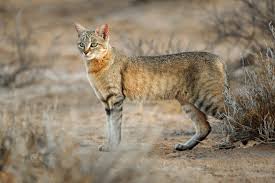
African wildcat
Conditions of detention
African Wildcats thrive in a variety of environments, including savannas, grasslands, and semi-deserts. They prefer areas with plenty of cover, such as bushes and tall grasses, where they can hunt and hide from predators.
Useful Fact:
African Wildcats are highly adaptable and can survive in various climates, from dry deserts to wetter grasslands, which is a testament to their resilience.
Nutrition and diet
African Wildcats are obligate carnivores, primarily hunting and consuming small mammals, birds, insects, and occasionally reptiles. Their diet is rich in protein, essential for their high energy levels and muscular build.
Useful Fact: African Wildcats have a high metabolic rate and need to hunt frequently, often consuming multiple small meals throughout the night.
Health
African Wildcats are generally healthy in the wild, with survival depending on their ability to avoid predators and find adequate food. They are susceptible to common feline diseases and parasites, which can impact their lifespan.
Useful Fact: African Wildcats have a lifespan of 10-12 years in the wild, but can live longer in protected environments or captivity.
Grooming and care
As wild animals, African Wildcats groom themselves to maintain their coat and remove parasites. They do not require human intervention for grooming in their natural habitat.
Useful Fact: African Wildcats have a natural instinct for grooming, which helps them stay clean and reduces scent markers that predators might detect.
Education and training
African Wildcats rely on instinct and experience for hunting and survival skills. They learn essential behaviors from their mothers during the early months of life.
Useful Fact: Young African Wildcats start learning to hunt by observing and mimicking their mother’s hunting techniques.
Toys and entertainment
In the wild, African Wildcats entertain themselves through hunting and exploring their environment. They engage in play behavior as kittens, which helps develop their hunting skills.
Useful Fact: African Wildcats use natural objects like leaves, sticks, and insects for play, honing their reflexes and predatory skills.
Safety
African Wildcats face threats from larger predators, human activity, and habitat loss. Conservation efforts are important to ensure their safety and preserve their natural habitats.
Useful Fact: African Wildcats often seek shelter in dense vegetation or burrows to avoid predators and extreme weather conditions.
Accessories
In their natural habitat, African Wildcats do not require accessories. They use their sharp claws and keen senses to hunt and navigate their environment.
Useful Fact: The African Wildcat’s retractable claws are crucial for catching prey and climbing trees to escape danger.
Socialization
African Wildcats are solitary animals, coming together only for mating. Kittens stay with their mother until they are old enough to fend for themselves.
Useful Fact: African Wildcats communicate through vocalizations, scent markings, and body language to establish territories and attract mates.
Travel and Transportation
African Wildcats have large territories and travel extensively within them to hunt and find mates. They are highly mobile and adaptable to different terrains.
Useful Fact: African Wildcats can travel several kilometers in a single night while hunting or patrolling their territory.
Behavior and psychology
African Wildcats are solitary, territorial, and highly independent. They are primarily nocturnal, using the cover of darkness to hunt and avoid predators.
Useful Fact: African Wildcats mark their territory with urine and scratch marks to communicate with other wildcats and establish boundaries.
Legal aspects
Conservation laws protect African Wildcats in many regions to prevent poaching and habitat destruction. It is illegal to capture or keep them as pets in most areas.
Useful Fact: African Wildcats are listed under the Convention on International Trade in Endangered Species (CITES) to regulate and monitor their trade and ensure their conservation.


